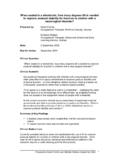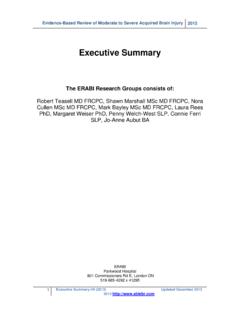Transcription of The Cognistat is a sensitive measure for screening and ...
1 Available free at Prepared by Rebecca Nicks, Nov 2007 1 The Cognistat is a sensitive measure for screening and identifying people with cognitive impairment following ABI in acute hospital settings Prepared by; Rebecca Nicks Occupational Therapy, The Royal Melbourne Hospital, Grattan St, Parkville, VIC Australia Date: November 2007 Review date: November 2009 CLINICAL SCENARIO: Following acquired brain impairment people may experience cognitive impairment that can impact on their functioning and occupational performance. Occupational therapists working in acute hospitals are required to quickly conduct assessments, formulate discharge plans and make recommendations regarding a persons occupational performance. The author wanted to investigate a tool that occupational therapists working in the acute hospital setting can use to assess cognition of people following acquired brain impairment.
2 FOCUSSED CLINICAL QUESTION: What is the most valid, reliable and sensitive measure for use by occupational therapists working in acute care settings to assess cognitive impairments that are likely to affect occupational performance in adults following an acquired brain impairment? SUMMARY of Search, Best Evidence appraised, and Key Findings: Five studies were located and critiqued. Three studies were appraised. No single paper directly answers the research question and no papers specifically considered the acute phase of care. Doninger and colleagues (2006) evaluated measurement properties of the Cognistat and found that the Cognistat can differentiate cognitive status in inpatients and community patients with TBI. There is insufficient evidence to support its use in identifying specific cognitive impairments. Lannin and Scarcia (2004) evaluated the concurrent and incremental of 5 different cognitive assessments.
3 The Cognistat was the most sensitive tool for detecting cognitive impairment; if used with the CAM, specificity increases. Nabors and colleagues (1997) retrospectively examined the concurrent validity of the Cognistat compared with standard neuropsychological measures. Results indicate that the Cognistat is useful in detecting cognitive impairment in the adult TBI population. CLINICAL BOTTOM LINE: The Cognistat is a sensitive measure of cognition that is quick to administer and enables therapists working in acute hospitals to screen people for cognitive deficits following acquired brain impairment. However, it cannot be used to accurately generate information regarding specific cognitive impairments. Available free at Prepared by Rebecca Nicks, Nov 2007 2 Limitation of this CAT: This critical appraisal has been peer reviewed by one university lecturer as part of an assignment. SEARCH STRATEGY: Preliminary searching revealed limited publications specific to the acute phase of care, therefore the population search terms did not specify the nature of the care setting.
4 Preliminary searching revealed that the Neurobehavioral Cognitive Status Examination - NCSE ( Cognistat ) and the Mini-Mental Status Examination (MMSE) are two instruments commonly used to assess cognition therefore these terms were included in the search strategy. The following databases were searched CINAHL, Medline, PsycINFO, Centre for Clinical Effectiveness, OT-CATs, OTseeker Terms used to guide Search Strategy: Population: brain injury, traumatic brain injury, brain damage, head injuries, acquired brain injury, acquired brain impairment, Assessment: cognitive evaluation, cognitive assessment, accuracy, sensitivity, validity, reliability, Cognistat , NCSE, MMSE, Comparison: cognitive assessments, Outcome: cognitive impairment, cognitive ability, ability levels, functional ability, activities of daily living Table 1: Summary of databases searched and search terms used.
5 Databases and sites searched Search Terms Limits used Medline CINAHL PsycINFO Brain injuries, cerebrovascular disorders, cognition disorders, adults, cognitive assessment, Cognition, functional outcomes, Cognistat , NCSE, MMSE, Brain injury, traumatic brain injury, head injury, brain damage, cerebral vascular accident, adult, cognitive evaluation, cognitive assessment, ability level, functional outcomes, Cognistat , NCSE, MMSE Head injuries, traumatic brain injury, brain damage, acquired brain impairment, cerebrovascular accident, cognitive impairment, cognitive ability, evaluation, cognition, cognitive assessment, Cognistat , NCSE, MMSE English text only Publications within the last 10 years (1997 to present). Available free at Prepared by Rebecca Nicks, Nov 2007 3 INCLUSION and EXCLUSION CRITERIA: Inclusion: Studies that investigated one or more cognitive assessments and reported on their reliability, validity or sensitivity for people with acquired brain impairment.
6 Publications available in English. Exclusion: Papers published before 1997. A critical appraisal that compared the Cognistat with the MMSE was located (Abdulwadud, 2002). This appraisal reviewed papers published in 1996 and 1987, thus papers only after this time were considered in this appraisal. Studies that did not specifically look at the reliability, validity or sensitivity of the cognitive assessments. Studies that describe neuropsychological assessments only. Studies that were exclusive to only one or limited areas of cognitive functioning, eg. executive functioning, inattention, perception, post traumatic amnesia. Studies exclusive to adults 50 years and above as the population under investigation typically involves people younger than this. Studies that did not include people with a traumatic brain injury, as this was one of the target populations of this review.
7 RESULTS OF SEARCH: Five relevant papers were located and categorised as shown in Table 2. Table 2: Summary of Study Designs of Articles retrieved based on Levels of Evidence, Centre for Evidence Based Medicine, (Phillips, Ball, Sackett, Badenoch, Straus, Haynes & Dawes, 2001). Study Design/ Methodology of Articles Retrieved Level Number Located Author (Year) Systematic Review of Level 1 studies 1a Validating cohort study 1b Systematic review of level >2 studies 2a Exploratory Cohort study (prospective, retrospective) 2b 3 CINAHL- Nabors et al., (1997) Medline Wallace et al., (2000) PsycINFO Lannin & Scarcia (2004) Systematic review of level 3b and better studies 3a Non- consecutive study 3b 2 CINAHL, Medline - Doninger et al., (2006), Doninger et al.
8 , (2000) Case-control study 4 Expert opinion 5 Available free at Prepared by Rebecca Nicks, Nov 2007 4 BEST EVIDENCE: The following papers were identified as best answering the clinical question and selected for critical appraisal: Doninger and colleagues (2006): Lannin & Scarcia (2004); Nabors and colleagues (1997). Reasons for selecting these papers were: No one paper directly answered the clinical question. These three papers provided the highest level of evidence for answering the clinical question and utilised a variety of designs appropriate to determine reliability, validity and sensitivity. The study by Lannin and Scarcia (2004) best addresses the clinical question. It compares the reliability, sensitivity and validity of a variety of cognitive assessments used in people following acquired brain impairment. However, it did not directly answer the question as it involved people in the rehabilitation setting.
9 The studies by Nabors and colleagues (1997) and Wallace and colleagues (2000) were similar as they both investigated the relationship between the Cognistat and established neuropsychological measures of related constructs in traumatic brain injury sample. The study by Nabors and colleagues (1997) was selected for appraisal as subjects were assessed much closer to time of injury compared with subjects in the study by Wallace and colleagues (2000). The study by Doninger and colleagues (2006) was selected as it contained the largest sample size and evaluated measurement properties of the Cognistat . It includes the sample reported in the study by Doninger and colleagues (2000) and thus this later study was not selected on its own. Critical Appraisal Checklists used: Fritz, , & Wainner, (2001). Examining diagnostic tests: an evidence based perspective. Physical Therapy 81(9), 1546-64. Greenhalgh, T.
10 (1997). How to read a paper: Papers that report diagnostic or screening tests. British Medical Journal, 315 (7107), 540-543. Herbert, R., Jamtvedt, G., Mead, J., & Hagen, (2005). Practical evidence based physiotherapy. Elseveir Butterworth Heinemann: London, pp. 116-122. Jaeschke, R., Guyatt, & Sackett, (1994) How to use an article about a diagnostic test. Accessed on 10th October, 2007 from Available free at Prepared by Rebecca Nicks, Nov 2007 5 SUMMARY OF EVIDENCE: Table 3: Description and appraisal of study by Doninger and colleagues (2006) Objective of the Study: To evaluate measurement properties of the Neurobehavioral Cognitive Status Examination ( Cognistat ). This included the ability to distinguish meaningful levels of cognitive impairment as well as ability to characterise specific types of cognitive impairment for adults with TBI from an inpatient sample compared with those living in the community.



